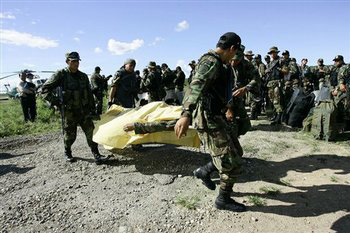
|  |  |  Americas & Beyond | June 2009 Americas & Beyond | June 2009  
Up to 36 Reported Killed in Amazon Land Protest
 Carla Salazar - Associated Press Carla Salazar - Associated Press
go to original
June 06, 2009


| | Police officers carry the body of a comrade killed during clashes with Indians in Bagua Grande, northern Peru, Friday, June 5, 2009. (AP) |  |
Lima, Peru — Indians protesting government moves to develop oil, gas and other resources on their lands battled police in Peru's Amazon on Friday, with authorities and Indian leaders separately reporting 11 police and 25 protesters deaths.

Accounts of the clashes and death tolls varied widely, as no independent journalists appeared to be present on the remote jungle highway in the northern province of Utcubamba where the fighting took place.

But the political violence was Peru's worst in years and augured ill for President Alan Garcia, who has championed development of the Andean nation's natural resources despite the objections of indigenous groups.

Authorities announced a curfew Friday night in the affected area, and announced 36 arrests. Interior Minister Mercedes Cabanillos said Indians were holding 38 police officers hostage at a facility belonging to state oil company Petroperu.

The violence erupted before dawn as officers broke up a road blockade by some 5,000 Indians in an area called Curva del Diablo, or "Devil's Curve."

Protest leaders said police opened fire from helicopters with bullets and tear gas, while national police director Jose Sanchez Farfan said protesters attacked officers, some with firearms. He said they also set fire to government buildings.

Cabinet chief Yehude Simon said that 11 police officers were killed – some with spears – and 109 people were injured. He said three Indians were killed in the clashes.

"One can't say that the natives were the victims," Simon told a news conference late Friday.

Farfan said at one point a group of six to eight policemen was surrounded on a hill by thousands of indigenous protesters who killed them and threw their bodies off the hilltop.

Protest leaders disputed the government's assertion, saying that 25 Indians, including three children, were killed in the clashes. They accused the government of "genocide" in attacking a peaceful protest. Another 50 Indians were injured, 14 of them seriously, said Servando Puerta, one indigenous leader.

Garcia, who has encouraged foreign oil investment and other development in Peru's pristine Amazon jungle, accused the main Indian leader Alberto Pizango of "falling to a criminal level: to assault a police post, grab arms from police, kill police who are fulfilling their duty."

Pizango denied that Indians killed police, saying the protesters were unarmed. He called for international human rights groups to intervene.

Indians have been blocking roads, waterways and a state oil pipeline intermittently since April, demanding Peru's government repeal laws they say make it easier for foreign companies to exploit their lands.

The laws, decreed by Garcia as he implemented the Peru-U.S. free trade pact, illegally open communal jungle lands and water resources to oil drilling, logging, mining and large-scale farming, Indian leaders and environmental groups say.

In addition to violating Peru's constitution, indigenous groups say Garcia is breaking international law by not obtaining their consent.

Garcia defends the laws as need to help Peru develop.

Peru's government owns all subsoil rights in the Andean country and Garcia has vigorously sought to exploit its mineral resources. A Duke University study published last year said contract blocks for oil and gas exploration cover approximately 72 percent of Peru's rain forest.

And though Peru's economic growth has led Latin America recently, Garcia's critics say little wealth has trickled down in a country where roughly half the population is indigenous and the poverty rate tops 40 percent.

Indians say Garcia's government does not consult them in good faith before signing such contracts which could affect at least 30,000 Amazon Indians across six provinces. Last month, Roman Catholic bishops in the Amazon issued a communique calling the Indians' complaints legitimate.

Pizango said last month that Indians would view any government security forces as an "external aggression" and would give their lives to defend the land.

Though he later rescinded what amounted to a declaration of insurgency, it is unclear how much influence Pizango, president of the Peruvian Jungle Interethnic Development Association, has over Indians in the conflict zone.

Garcia declared a state of emergency May 9 and suspended some constitutional rights in four jungle provinces as a result of the ongoing protests.

Because of the protests, the state oil company Petroperu stopped pumping oil through its northern Peru pipeline from the jungle on April 26. Company spokesman Fernando Daffos said the interruption had cost it $448,000 in losses.

Also affected is the Argentine company Pluspetrol, which halted oil production in two jungle blocks in the Loreto region of northeastern Peru.

Associated Press writers Franklin Briceno in Lima and Frank Bajak in Bogota contributed to this report. |

 |
|  |



